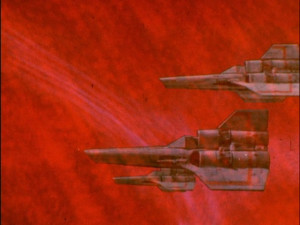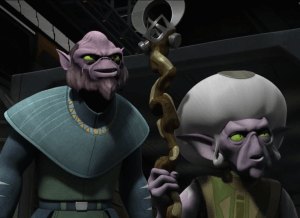Star Wars Rebels:
Legends of the Lasat and Other Alliterations
Teased as a look into Zeb’s past, “Legends of the Lasat” has a great deal more to it than simply telling us a bit more about the background of the Rebels’ hulk. Centered on a Lasat prophecy and flavored with a touch of piracy via fan-favorite Hondo Ohnaka, this episode could well be called “Prophecy and the Profiteer”. While one individual is motivated by the profits he could obtain by selling captives and information, others seek a paradise promised through an ancient prophecy. Or perhaps in reference to the various manifestations of the Force in different cultures, as evident in Chava’s reference to “Ashla”, this episode could find meaning in the title, “Flavors of the Force”. Ok, I admit, that’s a bit of an alliterative stretch, but hey — it gets to the heart of it, doesn’t it? The fact of the matter remains: this episode has much more going on than a 22-minute episode can possibly contain.
Mysteries and Mystics
The word mystery is a transliteration of a Greek word that simply means “something hidden”. Paying subscribers of Season Two of Rebels are certainly familiar with the idea of “something hidden”, having discovered that their subscriptions to the second season of this animated Star Wars series was for only half the episodes they had expected to receive when they purchased their subscriptions through iTunes, Amazon, or Google Play. In fact, the backlash against this hidden fact has been so negative that the ratings of Star Wars Rebels (Volumes 2 & 3) have suffered tremendously on Amazon, not because of the quality of the show itself, but because of the justly perceived deception of cutting Season Two into two volumes for those who purchase the series digitally. Had these online services simply been upfront with what was to be included in the original purchase price last fall, these negative responses could have been entirely avoided.
However, mysteries are generally well received among Star Wars fans. Hidden gems, surprises, and unanswered questions generally give rise to enjoyable discussions and numerous speculations about the potential plots in the future. After all, everyone has been buzzing about Rey’s heritage since her name was officially released early last year. As fans, we love to analyze and debate the possibilities about this galaxy far, far away. Last week’s episode of Rebels has certainly given us plenty to consider with all that lies beneath the surface of the story presented entitled “Legends of the Lasat”.
Many fans (especially “first generation” Star Wars fans) remember Glenn A. Larson’s amazing television show from 1978 that capitalized on the clamor for sci-fi during the initial run of Star Wars. Battlestar Galactica captured the imaginations of kids yearning for more of what they had seen in movie theaters. We were introduced to the tragedy of a people whose home planets were destroyed by a rising empire (Cylons with their Imperious Leaders) and their quest to find a home from legends long passed. Over the years, we have witnessed many tv shows and movies that profited from the success and popularity of Star Wars. With “Legends of the Lasat”, the circle is complete, as Rebels borrows from the program that borrowed from Star Wars. While the central plot of “Legends of the Lasat” is more than reminiscent of the plot of the entire Battlestar Galactica series, elements of this episode also hearken back to the first few episodes of the 1978 series. In the first few episodes of Battlestar Galactica, a story arc now known as “Saga of a Star World”, remnants of the Colonies escaped the Cylons by traveling through the Straits of Magadon, a dangerous rout e through the Megadon Nova. In the next arc, “Lost Planet of the Gods”, the Galactica travels through a mysterious void to discover an ancient tribal habitation and possible birthplace of the Tribes. “Legends of the Lasat” capitalizes on both of these story arcs, combining them into one voyage through an imploded star cluster to find Lirisan, the ancient homeworld of the Lasat.
e through the Megadon Nova. In the next arc, “Lost Planet of the Gods”, the Galactica travels through a mysterious void to discover an ancient tribal habitation and possible birthplace of the Tribes. “Legends of the Lasat” capitalizes on both of these story arcs, combining them into one voyage through an imploded star cluster to find Lirisan, the ancient homeworld of the Lasat.
Fan-made trailer for Battlestar Galactica “Lost Planet of the Gods”
Kevin Kiner attributes his inspiration for “Journey into the Star Cluster”, an oft-acclaimed musical addition to Star Wars, to Philip Glass. By perusing the Philip Glass catalogue, one can find a similar track from the 1982 documentary Koyaanisqatsi entitled “Pruitt-Igoe”. Apart from the distinctive mysterious tones of the string ensemble, the origins of Pruitt-Igoe reveal a story similar to the Lasat in Rebels. Due to overcrowding and poor living conditions in St. Louis in the late 1940s, officials embarked on a hopeful project to build modern low-cost housing to accommodate the growing population. Essentially, the older, decaying complexes were to be replaced with newer, better apartments. In 1955, thirty-three eleven-story apartment buildings were completed and named “Pruitt-Igoe” after two prominent St. Louis natives. Economic “refugees” from the deteriorating neighborhoods found a new home in Pruitt-Igoe. This musical cue from “Legends of the Lasat” has an underlying, hidden message in Kevin Kiner’s choice to use this Philip Glass composition as inspiration for the Lasat journey to their new home.
Video of “Pruitt Igoe” by Philip Glass from Koyaanisqatsi
Compare it with this track on StarWars.com
Beyond the theme and themes of “Legends of the Lasat” are the names of the key characters in this episode. At the outset, viewers are introduced to two other members of Zeb’s species. Those of us who, like Zeb, believed that he was the only remaining Lasat were excited to find out who they were and how they had survived the devastation of their homeworld, Lasan. Once liberated by the crew of the Ghost, we discover their names — and on further inspection, uncover their names’ potential significance (as we’ve noticed before in Rebels).  Gron reveals that he had formerly served in the Honor Guard under Captain Garrizeb Orrelios. Gron’s name sounds a bit like “ground” or even “green”. Its Dutch etymology stems from this sound in its meaning, “from the earth”. Gron is “rooted” in Lasat culture, and therefore seeks another homeworld for his people. Furthermore, the Kabalarian meaning of his name has to do with being parental and generous — a father-figure for all Lasat. When combined with Chava the Wise, whose name in Hebrew refers to life and, according to some, wisdom gained through life experience, becomes very telling when one considers that “Chavva” is the Hebrew transliteration of the Biblical character, Eve, who was given her name by Adam (which refers to coming “from the earth”) because she was the “mother of all living” (Genesis 3:20). That this connection is not by accident is accented when Sabine voices her assumption that the two Lasat are all alone on Lirasan. That these names were not randomly assigned is clearly evident, as even Zeb’s name takes on significance when we consider its Hebrew importance as “gift of God” and “dwelling of honor”. Zeb is the embodiment of the Lasat Honor Guard, as we have known, and is revealed to have a special “gift” that enables him, and him alone, to show his people the way home. The incredible detail that underlies every aspect of this episode is astonishing! By the way, I was surprised to discover that Hondo’s name has African roots and means “warrior” in Egyptian. And I thought he was “the fool” in the Lasat prophecy.
Gron reveals that he had formerly served in the Honor Guard under Captain Garrizeb Orrelios. Gron’s name sounds a bit like “ground” or even “green”. Its Dutch etymology stems from this sound in its meaning, “from the earth”. Gron is “rooted” in Lasat culture, and therefore seeks another homeworld for his people. Furthermore, the Kabalarian meaning of his name has to do with being parental and generous — a father-figure for all Lasat. When combined with Chava the Wise, whose name in Hebrew refers to life and, according to some, wisdom gained through life experience, becomes very telling when one considers that “Chavva” is the Hebrew transliteration of the Biblical character, Eve, who was given her name by Adam (which refers to coming “from the earth”) because she was the “mother of all living” (Genesis 3:20). That this connection is not by accident is accented when Sabine voices her assumption that the two Lasat are all alone on Lirasan. That these names were not randomly assigned is clearly evident, as even Zeb’s name takes on significance when we consider its Hebrew importance as “gift of God” and “dwelling of honor”. Zeb is the embodiment of the Lasat Honor Guard, as we have known, and is revealed to have a special “gift” that enables him, and him alone, to show his people the way home. The incredible detail that underlies every aspect of this episode is astonishing! By the way, I was surprised to discover that Hondo’s name has African roots and means “warrior” in Egyptian. And I thought he was “the fool” in the Lasat prophecy.
The Bottom Line
Regardless of how the additional, unexpected expense of purchasing the second half of Season Two (essentially, that’s what happened) has affected us personally, and in spite of not knowing just how profitable Hondo’s various attempts at remuneration for his efforts were to him, “Legends of the Lasat” has undoubtedly given us much more than our money’s worth for a single episode. Lengthy reviews have been penned and published online, podcasts have devoted hours of time discussing the themes and events of this episode, and ramifications that this single half-hour of Wednesday night television will be discussed and debated for days, weeks, and months to come.
BONUS HIDDEN MESSAGE
Translating from the Aurabesh text in the corridor reveals an advertisement for “Blue Milk”, saying that it’s available “at markets everywhere”. It even hints at another message for those lamenting the destruction of Lasan in its graphic depiction of spilled blue milk over a yellow background not to cry over spilt (blue) milk.
Author: shazbazzar
Stuart Tullis (shazbazzar) has been enamored with Star Wars since first seeing it at the drive-in with his family. The original trilogy dominated his youth until the Dark Times removed the toys from the stores in the mid-eighties. Rediscovering Star Wars at Mississippi State University with a housemate’s copy of Heir to the Empire, he has enjoyed the saga through toys, games, costumes, cartoons, TV specials, and books. Currently, he preaches for the Honeysuckle Road church in Dothan, Alabama where he lives with his wife, daughter, and son — two of which are avid Star Wars fans as well (his wife happily tolerates their fandom with a wink and a nudge). He is an active band parent who is always thrilled to hear the music of John Williams played by high school bands on the field and in concert halls. He is the co-host of TechnoRetro Dads on RetroZap.com. Follow shazbazzar on Twitter.
